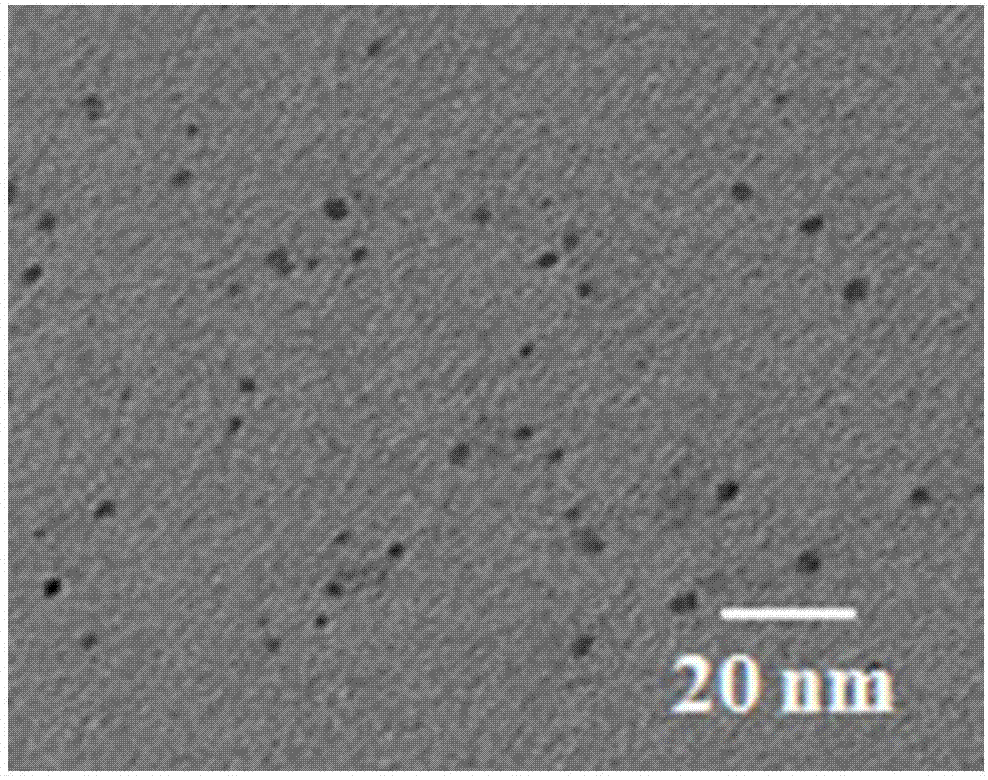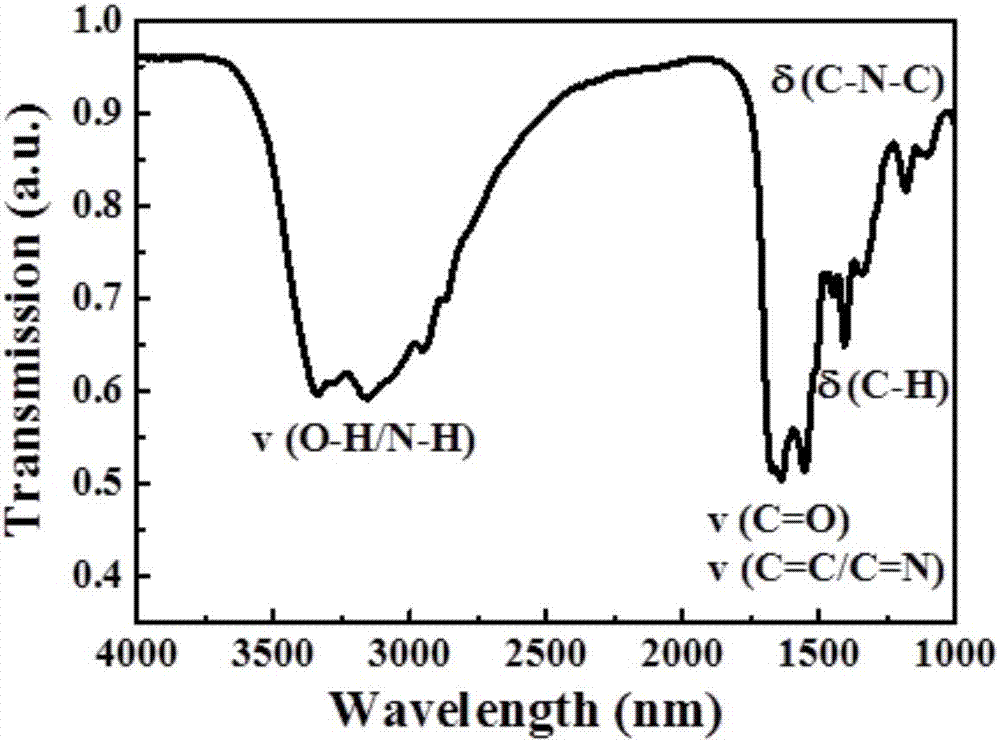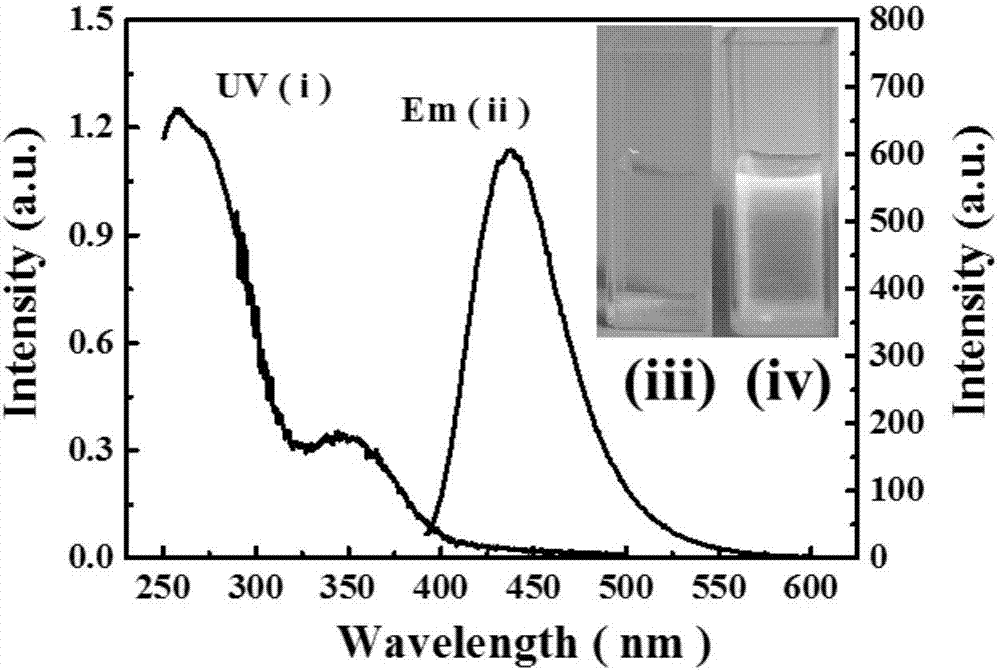Polymer carbon dot with high fluorescent quantum yield and preparation method thereof, and application of polymer carbon dot to targeted detection of tumor cells
A fluorescent quantum yield and polymer technology, applied in fluorescence/phosphorescence, chemical instruments and methods, measuring devices, etc., can solve the problem of low fluorescent quantum yield of polymer carbon dots, and achieve excellent fluorescent properties and stable fluorescent performance , Excellent stability effect
- Summary
- Abstract
- Description
- Claims
- Application Information
AI Technical Summary
Problems solved by technology
Method used
Image
Examples
Embodiment 1
[0024] (1) In a reactor containing 10 mL of deionized water, add 0.01 mmol of lysine and 0.01 mmol of folic acid, a material that has a targeting effect on cancer cells, and stir vigorously (400 rpm) at room temperature to make the two Fully dissolved to form a yellow aqueous solution;
[0025] (2) After putting the yellow solution obtained in step (1) into a microwave chemical reactor for 10 minutes, the solution changed from light yellow to dark yellow, and obtained polymer carbon dots;
[0026] (3) Filter the liquid obtained in step (2) with a 0.22 μm water phase filter head to remove impurities with larger sizes.
[0027] (4) Subsequently, the solution in step (3) was dialyzed with a dialysis bag with a molecular weight of 800-1000 for 48 hours, and the deionized water was changed every 4 hours. 3mL, measure the fluorescence quantum yield of the product to 56%, put the product in a 4°C refrigerator for later use;
[0028] (5) Dilute the polymer carbon dots obtained in st...
Embodiment 2
[0030] (1) In a reactor containing 10 mL of deionized water, add 0.02 mmol of lysine and 0.01 mmol of folic acid, a material that has a targeting effect on cancer cells, and stir vigorously (400 rpm) at room temperature to make the two Fully dissolved to form a yellow aqueous solution;
[0031] (2) Transfer the yellow solution obtained in step (1) to the lining of a 50mL polytetrafluoroethylene hydrothermal reaction kettle and install a steel jacket, gradually heat it to 180°C in an oven and keep the temperature constant for 10h, and naturally cool to room temperature to obtain Polymer carbon dot aqueous solution;
[0032] (3) Filter the liquid obtained in step (2) with a 0.22 μm water phase filter head to remove impurities with larger sizes.
[0033] (4) Subsequently, the solution in step (3) was dialyzed with a dialysis bag with a molecular weight of 800-1000 for 48 hours, and the deionized water was changed every 4 hours. 3mL, measure the fluorescence quantum yield of the...
Embodiment 3
[0036] (1) In a reactor filled with 12 mL of deionized water, add 0.01 mmol of tyrosine and 0.01 mmol of folic acid, a material that has a targeting effect on cancer cells, mix well at room temperature, and ultrasonicate for 10 minutes to fully dissolve the two , at which point a yellow aqueous solution was formed.
[0037](2) Transfer the yellow solution obtained in step (1) to the lining of a 50mL polytetrafluoroethylene hydrothermal reaction kettle and install a steel jacket, gradually heat to 180°C in an oven and keep the temperature constant for 10h, and naturally cool to room temperature to obtain Polymer carbon dots.
[0038] (3) Filter the liquid obtained in step (2) with a 0.22 μm water phase filter head to remove impurities with larger sizes.
[0039] (4) Subsequently, the solution in step (3) was dialyzed with a dialysis bag with a molecular weight of 800-1000 for 48 hours, and the deionized water was changed every 4 hours. 3mL, measure the fluorescence quantum yi...
PUM
 Login to View More
Login to View More Abstract
Description
Claims
Application Information
 Login to View More
Login to View More - R&D
- Intellectual Property
- Life Sciences
- Materials
- Tech Scout
- Unparalleled Data Quality
- Higher Quality Content
- 60% Fewer Hallucinations
Browse by: Latest US Patents, China's latest patents, Technical Efficacy Thesaurus, Application Domain, Technology Topic, Popular Technical Reports.
© 2025 PatSnap. All rights reserved.Legal|Privacy policy|Modern Slavery Act Transparency Statement|Sitemap|About US| Contact US: help@patsnap.com



